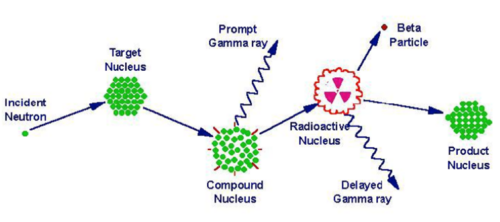Difference between revisions of "Forest NucPhys I Nuclear Reactions"
Jump to navigation
Jump to search
| (One intermediate revision by one other user not shown) | |||
| Line 19: | Line 19: | ||
;knockout reaction | ;knockout reaction | ||
: a & b are the same but there are 3 total particles in the final state. | : a & b are the same but there are 3 total particles in the final state. | ||
| − | : n + X \rightarrow Y + 3n = X(n,3n)Y | + | : <math>n + X \rightarrow Y + 3n = X(n,3n)Y</math> |
[[Image:KnockOut_Reaction_Forest_NucPhys_I.png | 200 px]] | [[Image:KnockOut_Reaction_Forest_NucPhys_I.png | 200 px]] | ||
| Line 30: | Line 30: | ||
;Nuclear PhotoEffect | ;Nuclear PhotoEffect | ||
: projectile a ejects a nucleon from target X | : projectile a ejects a nucleon from target X | ||
| − | :e - + Mo-100 \rightarrow Mo-99 + n + e- = X(e,e'n)Y | + | :<math>e - + Mo-100 \rightarrow Mo-99 + n + e- = X(e,e'n)Y</math> |
[[Image:NuclearPhotoEffect_Forest_NucPhys_I.png|200px]] | [[Image:NuclearPhotoEffect_Forest_NucPhys_I.png|200px]] | ||
| Line 47: | Line 47: | ||
This is typically a low energy reaction in which particle Y doesn't leave the target material but the intermediate state may be surmised at through the detection of particle b. | This is typically a low energy reaction in which particle Y doesn't leave the target material but the intermediate state may be surmised at through the detection of particle b. | ||
| − | [[Image:CompoundReaction_Forest_Nucl_I.png | 500 px]] | + | [[Image:CompoundReaction_Forest_Nucl_I.png | 500 px]][[Image:CompoundReaction_nf_Forest_Nucl_I.png | 500 px]] |
| − | |||
=Isospin= | =Isospin= | ||
Latest revision as of 23:36, 17 December 2015
Nuclear Reactions
Types of Reactions
- elastic scattering
- X & Y and a & b are the same particles, momentum and energy are conserved, typically all are in their ground state
- In-elastic scattering
- If Y or b are in an excited state, energy is not conserved it is used to excite one of the exiting particles.
- Note
- Elastic collisions are usually referred to as collisions and not nuclear reactions.
Direct Reactions
- knockout reaction
- a & b are the same but there are 3 total particles in the final state.
- Transfer Reaction
- a nuclear from projectile a is transfered to target X
- Nuclear PhotoEffect
- projectile a ejects a nucleon from target X
Capture
Compound reactions
- Compound reaction
- projectiel a is captured by target X forming an intermediate state which then decays, possibly through multiple excited nuclear states/species, to Y and b
This is typically a low energy reaction in which particle Y doesn't leave the target material but the intermediate state may be surmised at through the detection of particle b.
Isospin
14 nucleon system
Consider three different nuclear isobars all containing 14 nucleons ( isotopes are same Z, isotones are same N, so isobars are same A)
, ,
Experimentally it is observed that
has a half life of about 5000 years and a .
When it does decay it goes to by emitting a \beta^- particle with a Q value of 156.473 keV.
The state it goes to has
http://ie.lbl.gov/toi/nuclide.asp?iZA=60014
is stable.
The ground state of has a half life of about 70.61 seconds and a .
When it does decay it goes to by emitting a \beta^+ particle with a Q value of 5.143 MeV.





